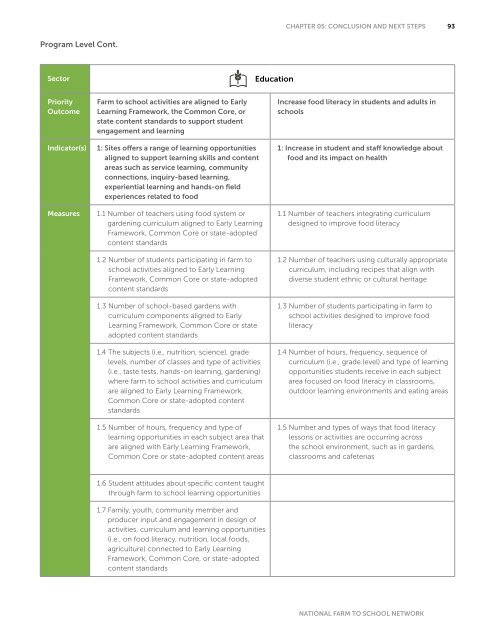Framework-08-25-14_web
Framework-08-25-14_web
Framework-08-25-14_web
Create successful ePaper yourself
Turn your PDF publications into a flip-book with our unique Google optimized e-Paper software.
CHAPTER 05: CONCLUSION AND NEXT STEPS93Program Level Cont.SectorEducationPriorityOutcomeFarm to school activities are aligned to EarlyLearning <strong>Framework</strong>, the Common Core, orstate content standards to support studentengagement and learningIncrease food literacy in students and adults inschoolsIndicator(s)Measures1: Sites offers a range of learning opportunitiesaligned to support learning skills and contentareas such as service learning, communityconnections, inquiry-based learning,experiential learning and hands-on fieldexperiences related to food1.1 Number of teachers using food system orgardening curriculum aligned to Early Learning<strong>Framework</strong>, Common Core or state-adoptedcontent standards1.2 Number of students participating in farm toschool activities aligned to Early Learning<strong>Framework</strong>, Common Core or state-adoptedcontent standards1.3 Number of school-based gardens withcurriculum components aligned to EarlyLearning <strong>Framework</strong>, Common Core or stateadopted content standards1.4 The subjects (i.e., nutrition, science), gradelevels, number of classes and type of activities(i.e., taste tests, hands-on learning, gardening)where farm to school activities and curriculumare aligned to Early Learning <strong>Framework</strong>,Common Core or state-adopted contentstandards1.5 Number of hours, frequency and type oflearning opportunities in each subject area thatare aligned with Early Learning <strong>Framework</strong>,Common Core or state-adopted content areas1: Increase in student and staff knowledge aboutfood and its impact on health1.1 Number of teachers integrating curriculumdesigned to improve food literacy1.2 Number of teachers using culturally appropriatecurriculum, including recipes that align withdiverse student ethnic or cultural heritage1.3 Number of students participating in farm toschool activities designed to improve foodliteracy1.4 Number of hours, frequency, sequence ofcurriculum (i.e., grade level) and type of learningopportunities students receive in each subjectarea focused on food literacy in classrooms,outdoor learning environments and eating areas1.5 Number and types of ways that food literacylessons or activities are occurring acrossthe school environment, such as in gardens,classrooms and cafeterias1.6 Student attitudes about specific content taughtthrough farm to school learning opportunities1.7 Family, youth, community member andproducer input and engagement in design ofactivities, curriculum and learning opportunities(i.e., on food literacy, nutrition, local foods,agriculture) connected to Early Learning<strong>Framework</strong>, Common Core, or state-adoptedcontent standardsNATIONAL FARM TO SCHOOL NETWORK


